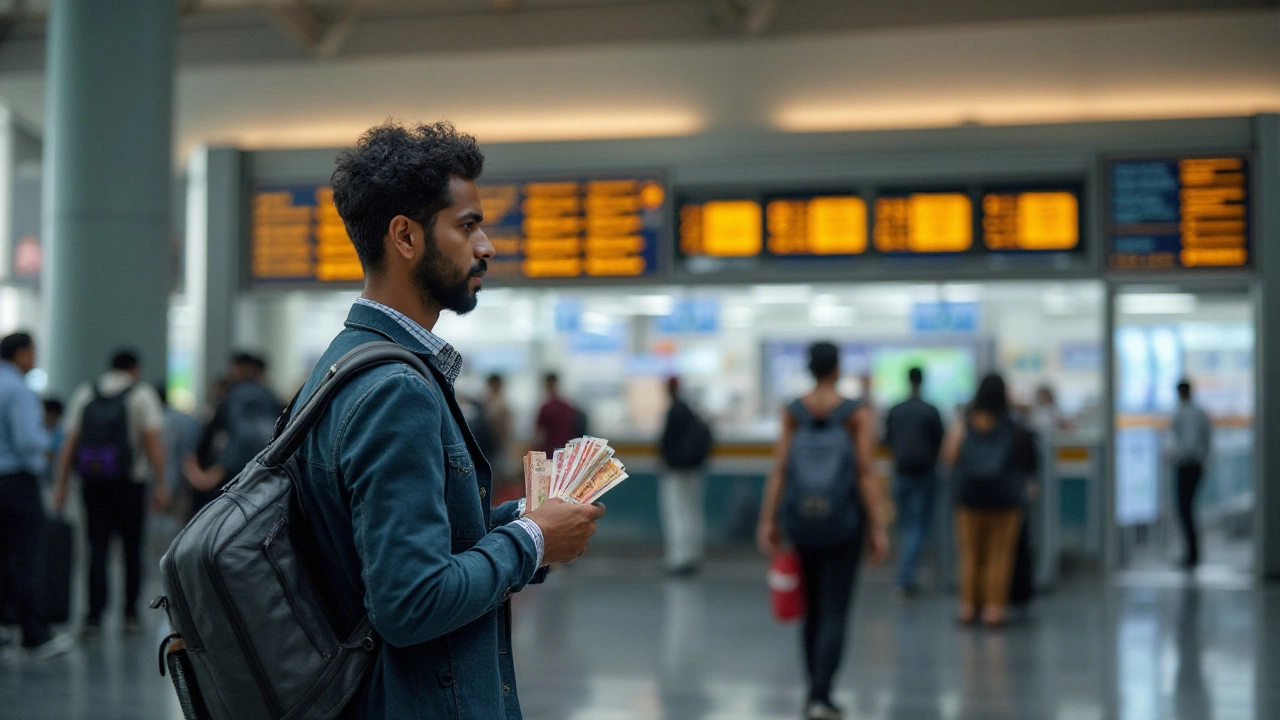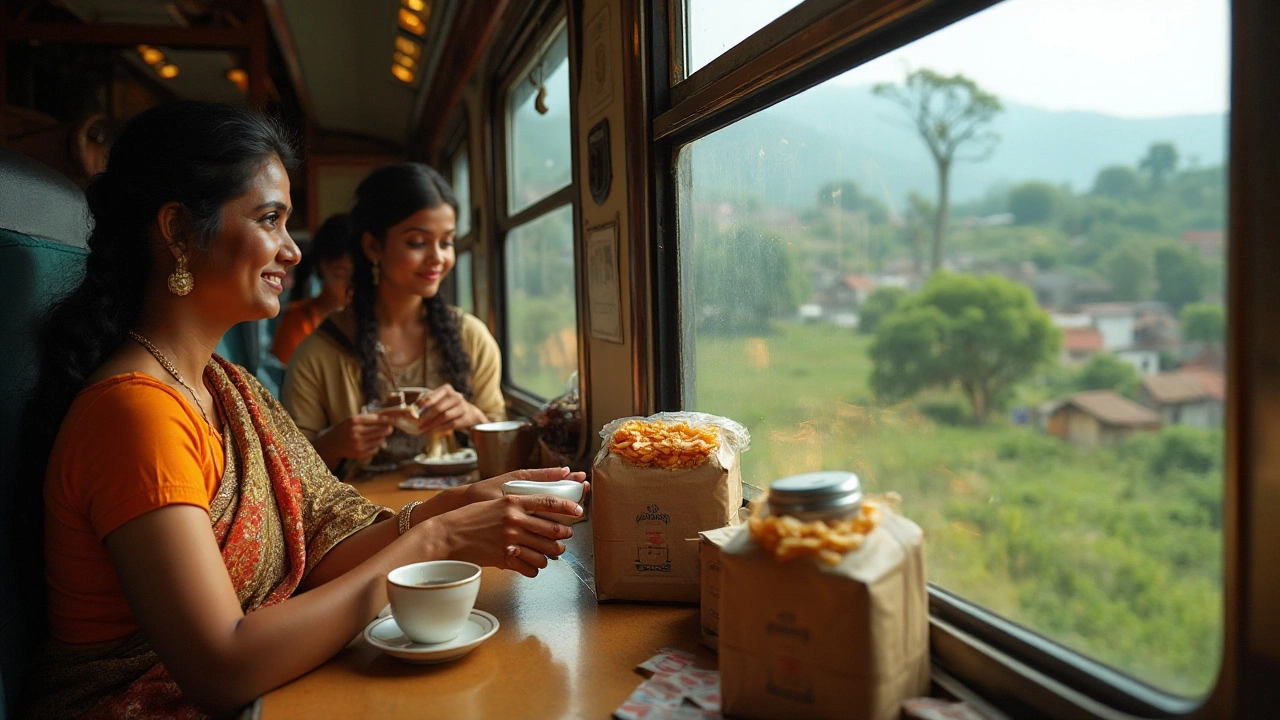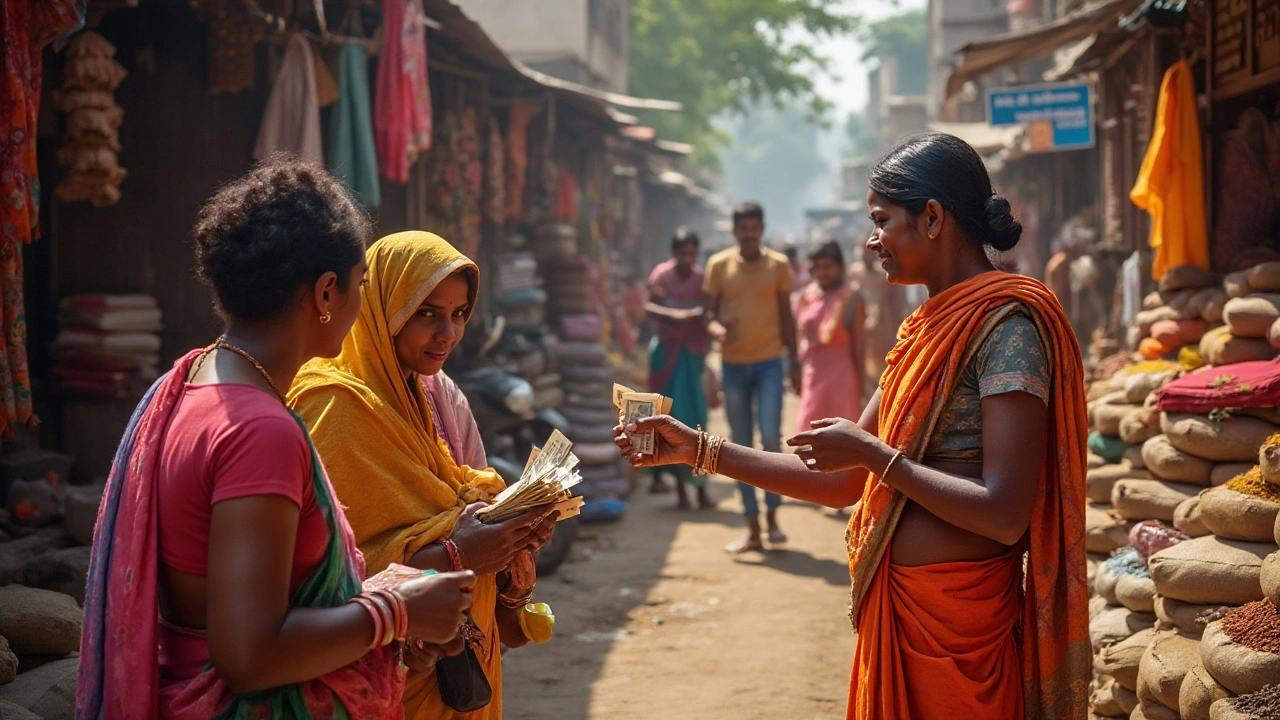Planning a trip to India comes with its blend of excitement and perplexity, especially when considering how much cash to carry. India is a land of contrasts with bustling cities and serene countryside, each presenting unique spending needs. While urban areas like Delhi and Mumbai embrace digital payments, cash remains vital in smaller towns and rural regions.
Mastering the art of managing cash while traveling in India can enrich your experience. Knowing the nuances of Indian currency, identifying trustworthy money exchange counters, and ensuring safety with your cash are pivotal. Let's dive into practical tips and insights to help you navigate your journey efficiently and economically.
- Understanding the Indian Currency
- How Much Cash to Carry for Your Trip
- Best Places to Exchange Money
- Using ATMs and Digital Payments in India
- Tips for Managing Cash Safely
- Budgeting for Different Travel Styles
Understanding the Indian Currency
When you're packing for an adventure in India, getting a handle on the local money is a must. The currency in circulation is the Indian Rupee, often seen abbreviated as INR. Before landing there, getting a feel for the bills and coins in your pocket is key. The Indian Rupee comprises banknotes in denominations like 10, 50, 100, 200, 500, and 2,000, making it important for tourists to recognize these values.
Coins are also part of the scene, with various denominations such as 1, 2, 5, and 10 rupees. Often, travelers find it confusing to handle small change, especially in bustling markets where every small coin counts. The government's periodic redesigns and new releases can sometimes add to the challenge, but don't worry. Once you get the drift, it's as smooth as silk. Numerous hawkers and sellers prefer exact amounts, so keeping some coins handy can make life easier.
"Using cash wisely in an environment that's still evolving can provide not only fiscal security but also a more enriched local experience," says travel expert and writer John Walker.As of late 2023, the exchange rate hovers around 83 INR for 1 US Dollar, though this rate often shifts. It’s smart to track the rate in the days before you travel to snag the best deal. With a better understanding of the currency, avoiding short-changing or overpaying becomes child's play.
Dealing with Currency Exchange
When stepping foot into India, first impressions may be overwhelming with the cacophony of vendors, travelers, and traffic. Before diving headfirst into this mosaic of color and sound, get a firm grip on your finances. Typically, the first encounter with the Indian Rupee is at exchange counters at airports, but these can sometimes have unfavorable rates. If swapping money, you're better off seeking authorized centers and banks within the city or using ATMs.
Tourists can convert foreign currency at licensed exchange counters, banks, or using ATMs that accept international cards. Most travelers prefer a mix of cash and credit cards for safety. It’s worth noting that possessing counterfeit notes is illegal in India, and diligence is required to avoid accepting fake currency. Look for the transparent window in the latest banknotes, alongside the Mahatma Gandhi watermark, to ensure your bills' authenticity. There are also subtle security features in bills that prevent the production of fakes.
Using kiosks in larger cities or ATMs affiliated with Indian networks is vital because smaller towns might not offer currency exchange services. Though many businesses in metropolitan areas accept international credit cards, having plenty of local cash on hand is advantageous for street shopping or quick bites at charming roadside food stalls. Understanding the currency is not just about numbers but also grasping the nuances that make Indian travel both genuine and unique.
Important Tips for Handling Indian Currency
Carrying cash in India requires knowledge and care. In large cities, electronic payments are gaining ground, but cash is often the lifeblood of transactions in smaller towns and local markets. Here's where recognizing and valuing your Indian currency tips come in. Always ensure that stored notes are unblemished, as overly worn or torn currency might not be accepted in some places. When exchanging money, try to obtain smaller denominations for easier management and transactions.
Understanding the rupee involves more than just familiarity with paper and metal. With precise management, your budget travel India experience can be rewarding and authentic. Merely being cautious and informed about the currency can keep mishaps at bay and help you remained focused on the vibrant journey instead. Remember that a little preparedness can significantly enhance your Indian escapade, allowing you to experience the country more freely.
How Much Cash to Carry for Your Trip
Deciding how much cash to carry when visiting India can be tricky, primarily because of the diverse nature of the locations you might explore. While places like New Delhi, Mumbai, and Bengaluru have the infrastructure for digital transactions, embracing terminals and apps, this isn't always the case in smaller towns or rural regions. It's essential to strike a balance – too much cash can be a safety concern, while too little might leave you unexpectedly stranded, unable to witness hidden gems off the beaten track.
Travelers visiting urban hubs could find themselves spending approximately INR 1,500 to INR 3,000 per day, accounting for meals, local travel, and some shopping. However, if you're heading into the countryside or smaller villages, a cash reserve of around INR 1,000 daily might suffice due to the lower cost of living and simpler amenities. Don’t forget that in bustling markets and local eateries accepting only cash, even in cities, having cash handy ensures you don’t miss out on eclectic experiences, from savoring spicy street food to winning a bargain at vibrant bazaars.
Thinking about dining? Expect to spend around INR 200 for a hearty meal at a local restaurant or street stall, while high-end or international dining establishments might charge upwards of INR 1,000. Local transport, like rickshaws and taxis, often requires cash payments, disregarding digital or card alternatives. For longer distances, prepaying using apps for transport is convenient. One pro-tip: Carry smaller denominations; larger notes can be troublesome when vendors fail to provide change, causing unnecessary hassle. A well-diversified wallet can keep day-to-day transactions smooth.
Budget travel India does not just mean sticking to a tight budget but rather spending wisely where it matters. Keep a portion of your budget in cash but ensure access to funds via cards or apps, too. For those looking for adventure, especially trekking in the Himalayas or spending time in remote areas, cash becomes a lifeline. In some regions, the nearest ATM or digital payment option could be miles away. It’s always preferable to overestimate your cash needs when venturing into such pockets of nature, providing a safety net if technology fails.
Security is a concern while carrying cash. Invest in a good money belt or pouch to keep your funds secure, and never exhibit large amounts openly. Distributing your cash in different parts of your luggage or person minimizes the risk of losing everything at once. Consider this advice a part of responsible traveling. Remember, ATMs are widespread in urban and semi-urban areas, though it's wise to have cash during bank holidays, weekends, or late-night arrivals.
According to a travel expert, "Cash is indispensable when exploring authentic experiences within India. Ensure you have enough but remain cautious and strategic about its storage and use."

Best Places to Exchange Money
When setting foot in India, exchanging foreign currency is among the first tasks on your travel checklist. Considering the vastness and diversity of India, one can find a myriad of options for exchanging money. The factors like convenience, exchange rate, and security profoundly impact the choice of place. Generally, international airports house numerous currency exchange counters. These kiosks provide convenience but are often notorious for higher fees and less competitive rates. Large airports such as Indira Gandhi International in Delhi and Chhatrapati Shivaji International in Mumbai serve as major hubs with decent services but remain unfriendly in terms of rates.
Many seasoned travelers suggest opting for nationalized banks like the State Bank of India or Punjab National Bank for more favorable exchange rates. Banking institutions typically offer better rates than airport kiosks, and while the process might be time-consuming, the savings can be worthwhile. Yet, another popular option includes hotel currency exchange desks. Though extremely handy for travelers staying at upscale hotels, the rates often do not match up to those provided by banks. However, the convenience might outweigh some financial pitfalls, especially after long flights or tiring journeys.
Adding another dimension to currency exchange are authorized money changers. Finding one is relatively easy in metropolitan areas—seek out recognizable names such as Thomas Cook or Travelex, both boasting a good international repute. These services are etched in many guidebooks, a testament to their reliability and customer-centric operations. In smaller towns and rural areas, local money changers serve as the primary outlets for currency conversion. While venturing into lesser-known territories, look for a licensed stamp or registration proof before proceeding with a transaction to avoid scams.
According to Lonely Planet, "With cash remaining King in India, especially for budget travel, the spots where you convert money become as crucial as the landmarks you visit."
Another modern method flourishing in India revolves around ATMs, clustered widely in urban zones. These machines typically disburse cash in local currencies at competitive rates, provided your bank fees don't eat into those advantages. Visas, MasterCards, and a few other international banking cards are broadly accepted. Watching out for fees that can accumulate significantly is key when choosing this option. Contact your home bank and local operator to verify Indian withdrawal charges before departure. This prudent step ensures transparency and preparedness in managing travel money in India.
For an effortless journey, engaging a mix of these cash management options seems ideal for a budget travel India experience. A calculated approach in blending ATMs with bank exchanges can maximize the value of your money. Tailor these recommendations to fit your personal travel style and itinerary, considering that certain regions, especially in the country's heartland, remain more cash-reliant than others.
Using ATMs and Digital Payments in India
India's financial landscape has seen tremendous growth with the rapid integration of digital payments, making it easier than ever for travelers to pay and withdraw cash on the move. Yet, navigating ATMs and digital payment methods in a foreign country can seem daunting at first. Most urban areas are well-equipped with ATMs that accept international cards, but it's always wise to check beforehand if your bank is tied to major networks like VISA and MasterCard. Conversion rates and fees might vary greatly, so consulting with your bank for international transaction costs is highly recommended. Trouble accessing your cash can be an adventure dampener, so always have a back-up plan, like carrying some cash in your home currency or another card.
A significant aspect of traveling in India is embracing the shift towards digital payments. Platforms such as Paytm, Google Pay, and PhonePe have revolutionized the way transactions are conducted, particularly in bustling cities. As per a report published by the Reserve Bank of India, digital transactions have steadily grown, increasing options for tourists. If you fancy street shopping or eating at local eateries, these applications can often get you substantial discounts while helping you travel budget-friendly. Setting up these apps can be done in a few steps, although connecting them with your international credit card might require additional verification. Always ensure your SIM card is ready for such apps by checking compatibility and data access, which are key factors for a seamless experience.
When using budget travel India strategies, having awareness of technological options and limitations when you're out in rural towns or lesser-known areas can be crucial. Many such places still rely heavily on cash, but digital payment options are gradually sprouting. Establishing communication with locals, asking about their personal preferences, and learning from their insights can guide you to make safe, informed decisions. Carrying small denomination notes can also be beneficial in these settings, and maintaining a balance between cash and electronic payments can ward off any potential financial hiccups. As one avid traveler once mentioned,
"Exploring India's vast and vibrant landscapes feels more connected when you're freed from financial hiccups, knowing your toolset of digital solutions and cultural awareness." - Travel Enthusiast BlogSafety should be a primary consideration, so opt for reputed apps and services and maintain security measures like two-factor authentication where available.

Tips for Managing Cash Safely
When traveling through India, ensuring your cash is managed safely is key to a hassle-free journey. One of the foremost concerns is protecting your monies from theft. Always divide your cash into multiple parts instead of keeping all your funds in one spot. This way, if one stash is lost or stolen, you won't be in a complete bind. Consider using a money belt or a hidden pocket to keep your cash and important documents secured and less accessible to pickpockets. This might feel cumbersome at first, but it acts as a reliable safeguard against unexpected losses.
Another effective strategy is to be discreet when handling money in public. Refrain from openly counting large wads of cash which might attract unnecessary attention. Instead, calculate the amount you need beforehand and keep that handy in a small pouch or wallet. When using ATMs, prefer those located in secure and well-lit areas. Bank-operated ATMs in malls or near police stations are generally safer options. You also benefit from having a trusted travel companion or friend to accompany you during these visits for added security.
Cash toning can be crucial too. While it might sound intriguing, this technique involves carrying notes in small denominations. Indian vendors and cab drivers might not always have change for larger bills, such as 2000 INR, so having smaller bills guarantees smoother, hassle-free transactions. Another nifty tip is to always keep a few coins handy, as they are perfect for making small purchases or tipping, without digging into your main stash of currency.
"In India, cash is king, particularly in small towns," advises seasoned travel writer, Mary Morris. "Yet, knowing how to manage this cash safely can make all the difference in an enriching travel experience."Moreover, safeguard your cash with a digital backup like a scanned copy of your money, passport, and other essential documents. Store these electronically accessible files in a cloud solution like Google Drive. In the unfortunate case your wallet goes missing, having immediate access to this information can save you significant time and stress.
Consider subscribing to alerts that update you on the status of your bank transactions. This additional step helps track your spending and swiftly identify any unauthorized access. It also encourages a conscious awareness of one's budget, assisting you in adhering to the limits set. Trustworthy travel insurance with coverage for lost or stolen cash can offer reassurance as well. This might feel like an extra expense, but should an unfortunate event occur, you may find it invaluable. Once you employ these varied strategies, you're bound to navigate India's vibrant locales with both confidence and financial security intact.
Budgeting for Different Travel Styles
When considering a trip to India, the budget you allocate largely depends on your travel style. Are you a backpacker seeking the raw, unfiltered beauty of local wonders, or do you prefer a more comfortable approach, enjoying amenities at picturesque resorts? Each style dictates how much cash you'll need, and it's crucial to assess your preferences and priorities before setting an amount.
For those embracing the backpacker lifestyle, India offers a vibrant and diverse range of experiences without straining the pocket. Budget travelers can survive on about $20 to $30 per day, with hostels and budget hotels offering rooms for as low as $5 to $10 a night. Eating street food is not only economical but also a gastronomic delight, costing a mere couple of dollars per meal. Public transportation such as buses and trains are highly affordable and efficient, making it easy to navigate between cities. Bond with fellow travelers and locals to uncover hidden gems known only to insiders, which often boast lower entry fees than more popular sites.
Mid-Range Travelers
If you're someone who prefers a mix of comfort and adventure, budgeting around $50 to $100 per day would suffice. Mid-range accommodations offer increased comfort with better amenities, providing a nice balance between experience and relaxation. Dining at moderate restaurants allows you to savor regional specialties without breaking the bank, as meals often range from $10 to $15. Add to this the cost of using ride-sharing apps to reach less accessible destinations or indulging in local experiences like crafts workshops, and you can expect a fulfilling yet affordable stay.
“India is a land of diverse experiences, and there's always something suitable for every budget. Whether you're a backpacker or a luxury traveler, the country welcomes you with open arms.” — Travel & Leisure
Luxury Travelers
For luxury travelers, India offers a plethora of opulent experiences, from staying at majestic palaces to dining at Michelin-star restaurants. Expect to budget upwards of $200 per day, as you'll be indulging in high-end accommodations that offer world-class amenities and services. Private tours, personal guides, and exclusive experiences like hot-air balloon rides over the desert could enhance your journey, providing memories that last a lifetime. While cash is less frequently needed in this travel style, having a small amount on hand for tips and incidentals can prove useful in making your interactions more gracious.
Regardless of your travel style, understanding the dynamics of Indian currency, being mindful of fluctuating exchange rates, and adopting a proactive approach towards safety will ensure a smoother trip. Whether you choose to travel on a budget or splurge a little, India presents innumerable options to tailor an experience that suits your pace and taste. Always keep some cash handy for those impromptu purchases or unexpected adventures that come along the way!
